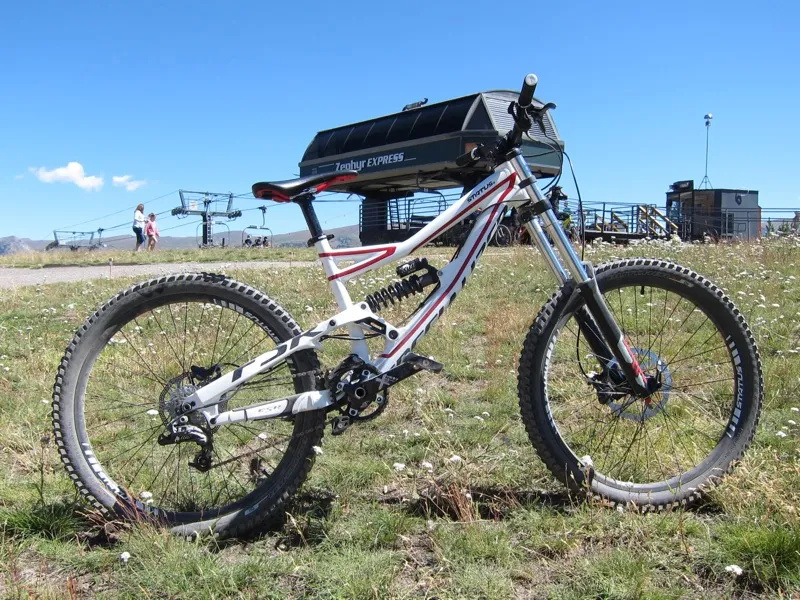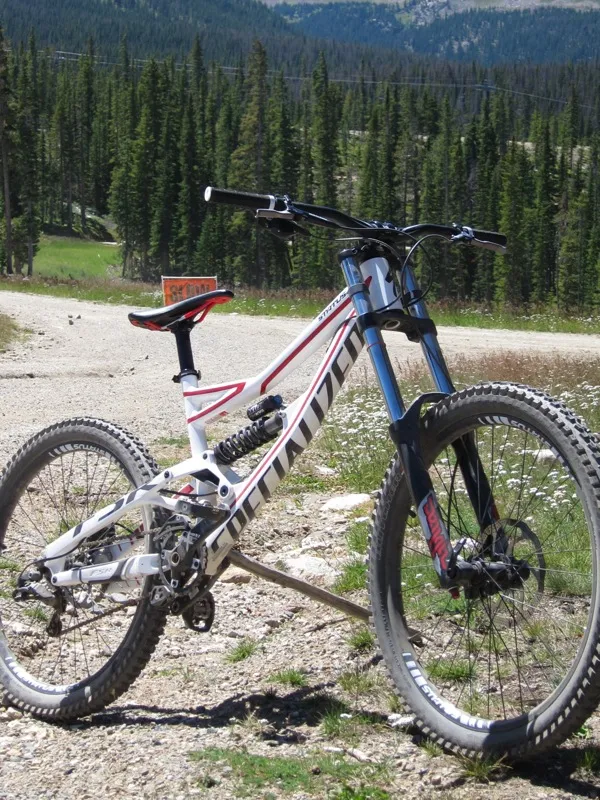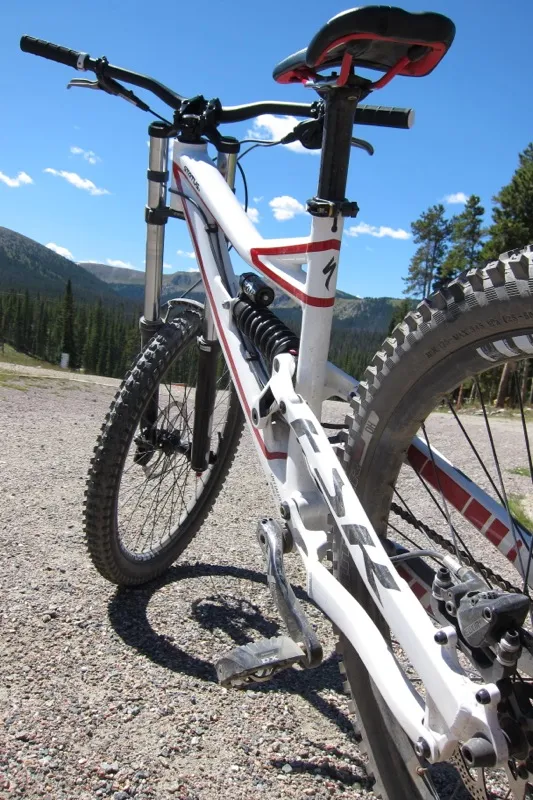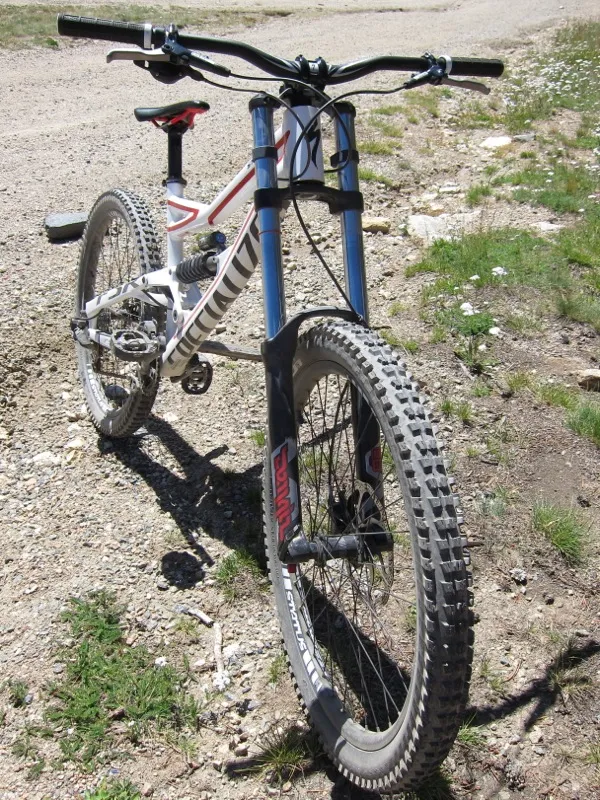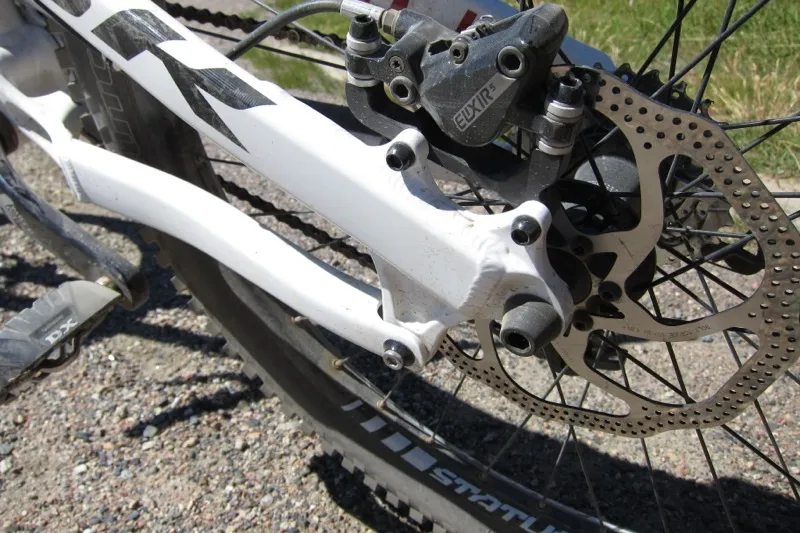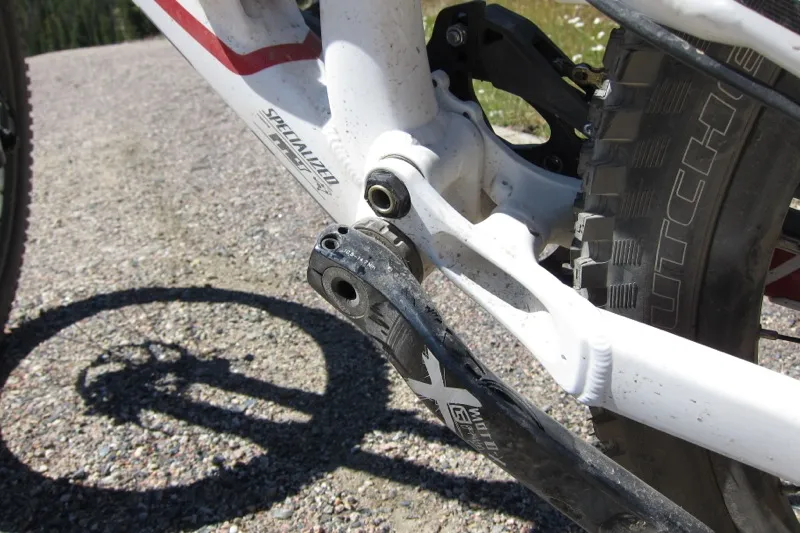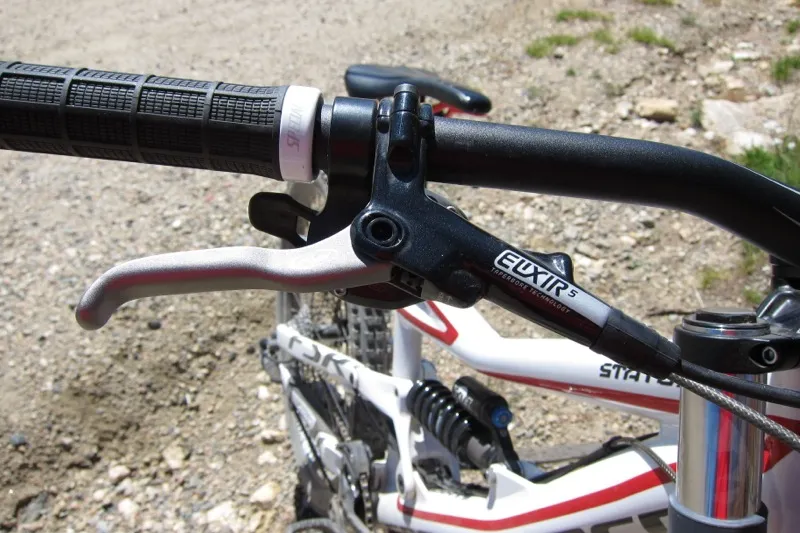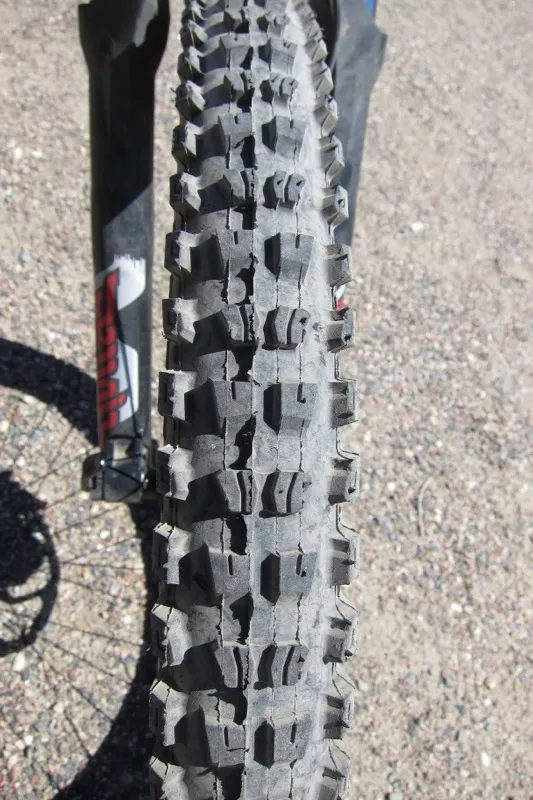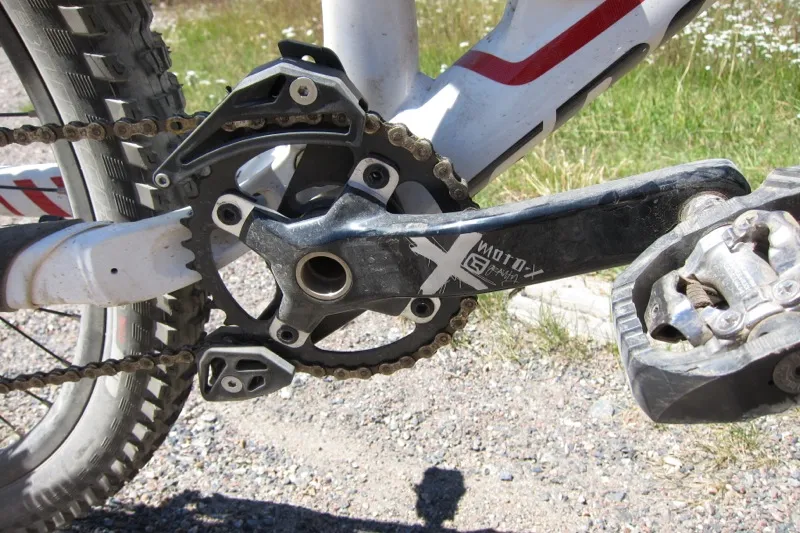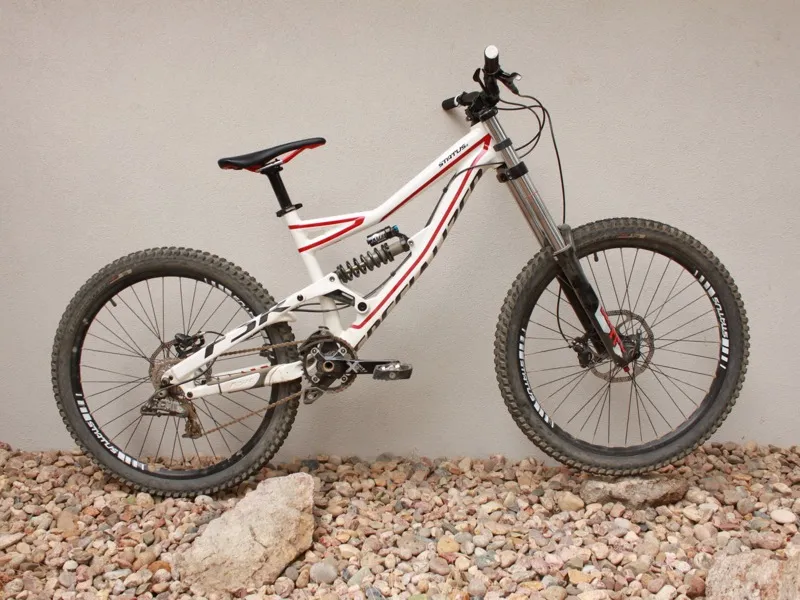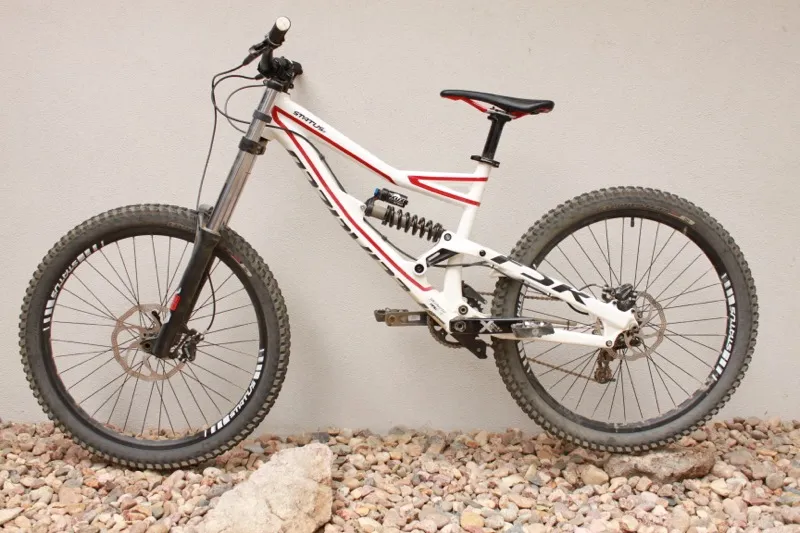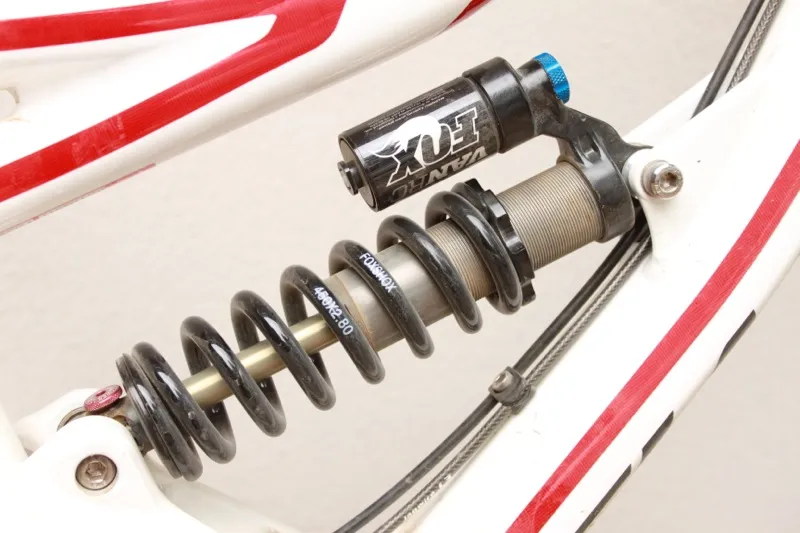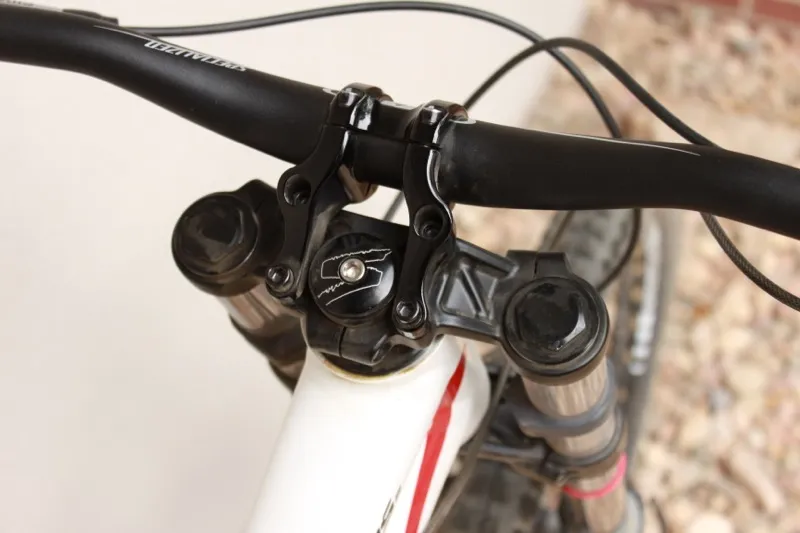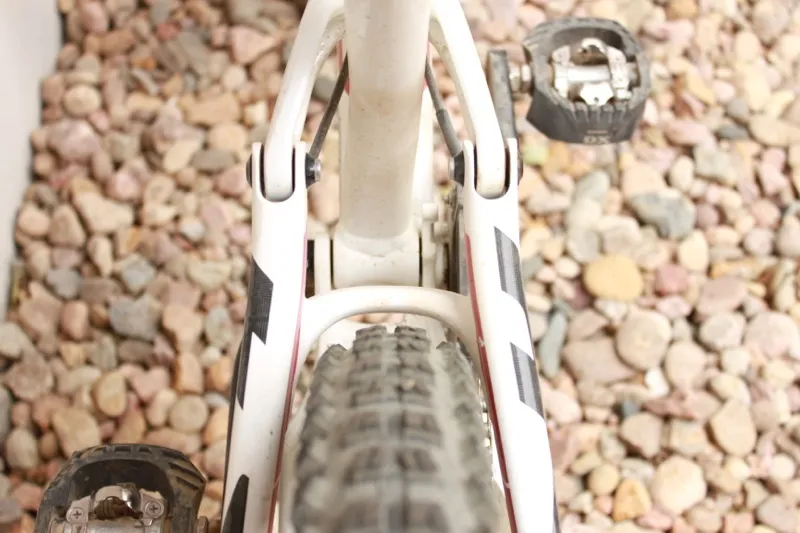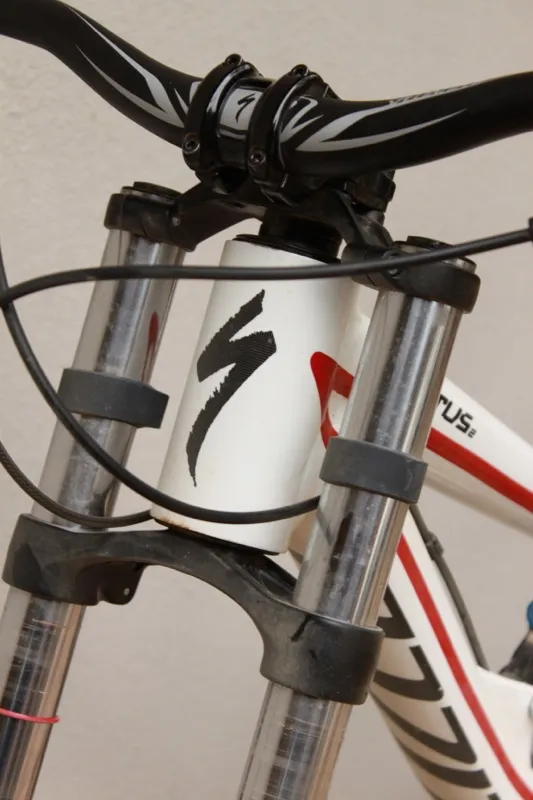The Status is a race-inspired entry-level downhill bike that replaces the stalwart Big Hit model in Specialized's 2012 line. It's got great angles – inspired by its bigger brother, the Demo – modern looking lines, a well thought component specification and one of the lowest prices around for a dual-crown-fork equipped downhiller.
The Status 2 thrives in the bike park, whether hucking drops or searching for flow on jump trails. Here, it easily keeps pace with bikes costing twice as much. Throw it into more natural terrain though, and some issues arise. The biggest problem is the performance of its budget RockShox Domain R fork, but overall weight and disappointing rear-end stiffness also conspire to hold its rider back.
Ride & handling: Geometry is spot-on, but technical terrain requires some serious muscle
The Status's 64.5° head angle, 71° seat angle and 355mm (13.97in) bottom bracket height offer a well-mannered ride to novice gravity riders and experts alike. In fact, the bike will be used by Specialized's US Gravity team (Curtis Keene and Brad Benedict) during the coming season on the Pro GRT and World Cup circuits. Paired with 165mm cranks across the three-size range, the bottom bracket is low enough for confident cornering but high enough that we rarely had impact issues.
If the geometry is dialed, so is the 200mm of FSR-actuated rear suspension travel. The spring curve is less progressive than that of the Big Hit models the Status replaces, and our medium tester was set up with a just-right 450lb spring weight that allowed us to tune the Fox Vanilla RC rear damper to ride perfectly.
The majority of unwanted pedaling feedback was easily tuned out with the low-speed compression adjustment and we found ourselves right in the middle of the rebound range, which allowed us to easily fine-tune for high amplitude hits, big jumps and drops, high frequency impacts and just about everything in between.

We were very happy with the performance of the Van RC shock
Despite the great performance of the rear suspension, the Status's ride was hampered by a lack of rear-end stiffness. This manifested itself in a sensation best described as a 'wiggle' that was most apparent in high-speed G-outs, big-drop bottom-outs and rock gardens that try to twist the wheels out of plane and off the bike. It seemed to come from either the rear dropout or the rear wheel, but we were unable to confirm the exact source during our limited test period.
A few years back, 42.35lb (19.21kg) would have been a good weight for a downhill bike. Now, with sub-35lb bikes appearing on the World Cup circuit, it seems heavy, especially considering the last generation Big Hit was several pounds lighter. A lot of that weight comes from RockShox's 7.61lb steel-stanchioned Domain R fork, although the wheels are also partly to blame.
Because of its heft, the Status takes muscle to ride on more challenging terrain, especially when the name of the game changes from flow to find-the-line (the fastest or otherwise). On trails with flow, jump trails and those with well-defined and beat-in lines, the bike hides its heft fairly well (although off big drops and jumps with substantial hang-time you can actually feel the heavy wheels spinning).
However, the weight quickly catches up with the rider on trails that require frequent direction changes and intricate line selection. We found that while we could ride jump trails all day on the Status 2, just a couple of runs on a proper downhill track jellied our upper body.
We've come away from our time with the Status 2 with memories of fun times in the bike park so if that's your aim, and you're on a budget, the bike will serve you well. If you're looking to break onto the downhill race scene, however, be prepared to address a few issues. We see the fork as the place to start – where an upgrade could definitely skew our score for the better – and the wheelset as a potential place to drop weight and add rear-end stiffness, which could ice the cake.

The RockShox Domain R fork's performance was an issue for us
Frame: Slick looks and great suspension but we wish it had through-axle dropouts
Built out of Specialized's M4 alloy tubing, the Status looks contemporary and it looks fast – Specialized's industrial designers get a gold star for the aesthetics. The 1.5in head tube sets the tone for the front triangle – the big tube allows the rider to point the bike confidently where they want it to go – and the bike seems to remain very stiff across the massive main FSR linkage, which pivots on sealed cartridge bearings, and through the clean lines of the rear stays.
However, somewhere in the back of the bike we found a wiggle, which we think may come from the standard 135mm quick-release dropouts. While the rear wheel is affixed using a massive 10mm steel axle, the dropouts are open and the wheel is built upon a standard flanged hub that's upwards of 15mm narrower than those found on many of the Status 2's competitors. Whether the wiggle comes from there or the rear wheel itself, it's present, and unwanted.
Part of the reason for the open dropouts is that Specialized have shared many of the tube profiles and forgings of a past edition of their SX Trail with the new Status. This is understandable in terms of manufacturing efficiency but the end result is a bit of a letdown, especially considering the 2012 SX Trail comes with a 142x12mm rear end.
"We're trying to keep the bike accessible for entry-level budget [minded] riders," Joe Buckley, one of Specialized's mountain product managers, told BikeRadar. "When we go to Whistler the kids have bikes that are just cobbled together, and if they blow up a wheel then they just replace it with whatever wheel they can get their hands on. The availability of 135mm spaced wheels is a lot greater than 150mm wheels at this point... and they're [150mm spaced wheels] considerably more expensive. We made a conscious decision to keep it 135mm."
The repurposed stays, complete with direct mount tabs for a front derailleur, transition to the main frame through a wide pivot equipped with sealed cartridge bearings, just above the 73mm bottom bracket shell, which comes with ISCG tabs.

Despite the 10mm steel through-bolt, we found the rear end soft
Equipment: Overall a good package, but we'd make a few big changes
At US$3,100 the Status 2 is one of the most economical dual-crown equipped downhill bikes on the market. Specialized do have competitors nipping at their heels, though, and these rival bikes tend to sport two key – almost imperative – upgrades: RockShox's BoXXer RC fork and 150x12mm downhill-specific rear ends.
The Domain R doesn't compare favorably to the BoXXer RC. It weighs 7.61lb (actual), as opposed to the BoXXer's 6.35lb (claimed), and while the latter costs roughly $200 more, it's money well spent since it offers low-speed compression adjustment and, more importantly, RockShox's Dual-Flow rebound damping.
While the Domain's weight undoubtedly contributed to our jellied upper bodies after the downhill runs, its rather basic rebound damper (RockShox call it single-flow) was primarily to blame, with a harsh feel over multiple hits that wasn't felt on big single impacts like jumps and drops.
One note for those rolling out the shop door with a 2012 Status 2, or any downhill bike for that matter – it's worth spending the time to get the spring rate and suspension sag right before plunking down the plastic and hitting the park. It's not just a matter of adding or subtracting air from these shocks; because they're coil sprung, they require spring changes. We went from the fork's stock medium spring down two steps to an extra-soft spring and still had to really bash stuff to get full travel out of it.
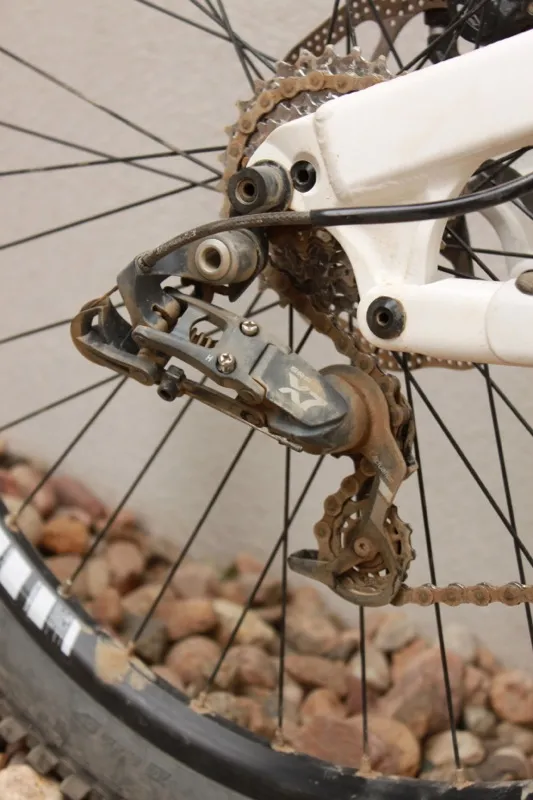
SRAM's X7 short-cage rear derailleur – perfect for the blue-collar downhiller
While the fork is a relatively easy upgrade – at considerable cost, of course – adding stiffness to the rear end is considerably more challenging. A stiffer wheel might help but it's unlikely to match the strength and stiffness of 150x12mm axle. This is the Status's Achilles heel.
Aside from these issues, the Status 2's spec was spot-on; from the direct mount stem to the 750mm-wide low-rise Demo handlebar, to the short cage SRAM X7 rear derailleur and downhill-specific gearing, which pairs a 36-tooth chainring with an 11-28T nine-speed cassette. The Avid Elixir 5 brakes were well bled but the extra power of a 200mm rear rotor, rather than the 180mm fitted, wouldn't have been wasted.
The Specialized Butcher 2.3in soft compound tires had excellent grip, despite their fast wearing treads. They offered consistent, predictable traction over a range of dry to mixed conditions, and the downhill-specific casing prevented any flats during the duration of our testing. Specialized equip the tires with properly thick downhill inner tubes too, despite the allure something lighter may offer on paper or the shop floor.
